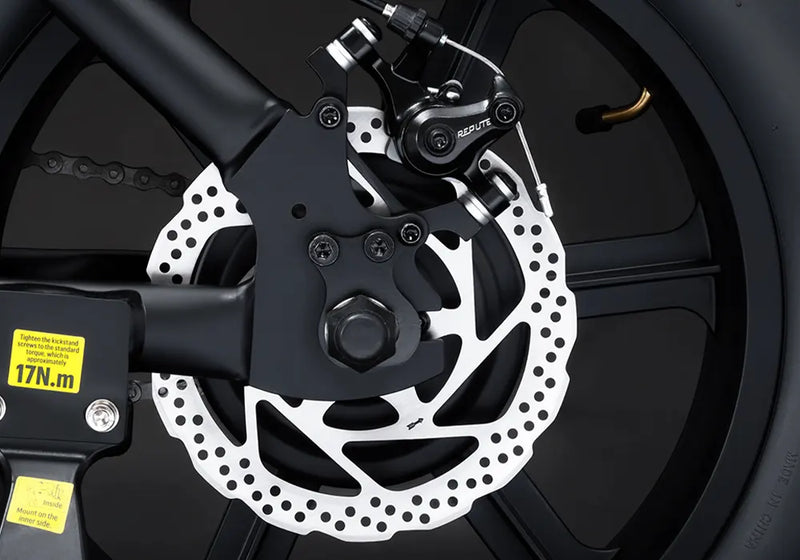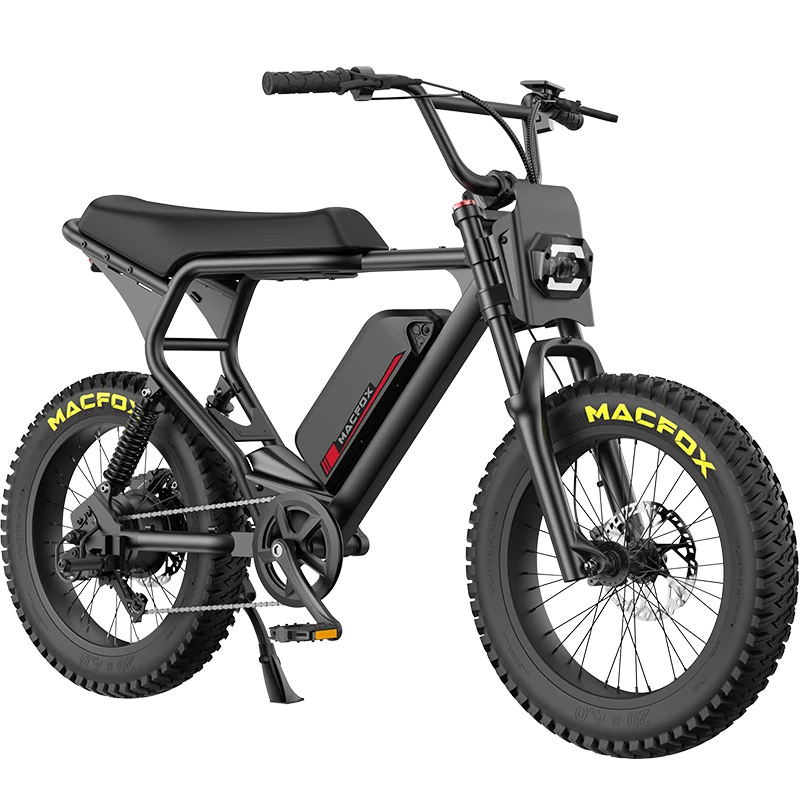There isn’t one “standard” number. It depends on the drive type. Direct-drive hub motors are 1:1 (no reduction). Most geared hub motors use a planetary reduction around ~5:1, while some compact hubs run ~11–13:1.
Mid-drives add internal reductions and then use your bike’s chainring/cassette, so the overall reduction to the wheel varies with your gear (e.g., Bosch systems spin a small chainring 2.5× per crank revolution).
More reduction = more wheel torque and easier climbing; less reduction = higher top speed (all else equal).
Featured summary (what matters most)
-
Definition: Reduction ratio = how much a gearbox slows speed and multiplies torque from motor to output. Example: 5:1 divides speed by 5 and (roughly) multiplies torque by 5 (minus losses).
-
Direct-drive hub: 1:1, motor turns at wheel speed. Quiet glide, allows regenerative braking; heavier and less punchy at low speed.
-
Geared hub: ~5:1 common; small/light with strong starts; no regen, has internal gears. Some compact hubs reach ~11:1.
-
Mid-drive: Internal stages + your bike gearing; Bosch small ring spins 2.5× per pedal rev (feels like a larger chainring). Overall reduction depends on the cassette gear you choose.
-
Choosing: Steep hills/cargo → higher reduction (or use low bicycle gearing). Fast commuting/flat → lower reduction (or shift to higher bicycle gears).
What “reduction ratio” means
Definition. Reduction ratio = input speed / output speed of a gearbox. In gears, it equals large-gear teeth ÷ small-gear teeth. It reduces rpm and multiplies torque at the output, with small efficiency losses.
Core trade-off. More reduction → stronger starts and climbing; too much → you run out of top speed. Less reduction → higher speed potential; too little → weak launch/overheat risk on hills.
Typical reduction by e-bike drive type
| Drive type | Internal reduction (typical) | How it works | What it feels like |
| Direct-drive hub | 1:1 | Motor stator in the hub turns the wheel directly. | Smooth, silent glide at speed; heavier; regen possible. |
| Geared hub (planetary) | ≈ 5:1 (many) | Small high-rpm motor drives planetary gears to slow output and boost torque. | Punchy takeoff, lighter hub; slight gear noise; no regen (one-way clutch). |
| High-reduction compact hub | ≈ 11:1 (e.g., Bafang G310) | Multi-stage helical gearing for tiny, quiet hubs. | Great for hills/low-speed assist; limits top speed on large wheels. |
| Mid-drive | Internal stages + bike chain/cassette | Motor reduces to a chainring; you then shift for wheel reduction. Bosch small chainring spins 2.5× per crank rev. | Broad usable range; climbs well using low gears; overall ratio changes with your shift. |
Key point: a direct-drive runs at wheel rpm; a geared hub lets the motor spin faster internally (more efficient rpm range) and gears it down to wheel speed.
Recommended: How To Increase The Speed Of My Electric Bike?
How to calculate your overall reduction to the wheel
There are two layers you can multiply:
-
Motor gearbox reduction (if any)
-
Bicycle drivetrain ratio = front chainring teeth ÷ rear sprocket teeth
Overall speed ratio (motor → wheel)
Example A — geared hub (5:1), single-speed 44:16:
Wheel RPM = Motor RPM ÷ 5 × (44/16) = Motor RPM × 0.55.
Example B — mid-drive (Bosch small ring 2.5× at the ring), 34T ring to 51T sprocket:
Crank RPM → Ring RPM = ×2.5; Drivetrain = 34/51 = 0.667.
Effective crank→wheel ratio ≈ 1.67:1 before wheel circumference. The overall feel still depends on which cassette cog you pick.
How reduction changes ride feel
-
Hill climbing & starts: Higher reduction or lower bicycle gears = easier launches, less motor stress.
-
Top speed: Lower reduction or higher bicycle gears = more speed at a given motor rpm.
-
Efficiency & heat: Letting the motor run at a higher internal rpm (via gearing) often improves efficiency at low road speeds vs. forcing it to crawl at wheel rpm (direct drive).
-
Coasting/drag: Direct-drive hubs can show more cogging drag when unpowered; geared hubs freewheel via a clutch.
-
Regenerative braking: Only practical with direct-drive hub motors (no clutch).
Picking the “right” reduction (by use case)
-
Steep cities, cargo, heavier riders: Favor geared hubs (~5:1) or mid-drives and pair with wide-range cassettes. Consider compact high-reduction hubs (e.g., ~11:1) for low-speed hill work.
-
Flat, fast commuting with regen desire: Direct-drive (1:1) for smooth high-speed cruising and braking energy recovery.
-
Mixed terrain & riders who like to shift: Mid-drive for the broadest gearing spread (your cassette does the final tuning). Bosch’s 2.5× small chainring behavior is normal.
FAQs
Is 5:1 “better” than 11:1?
Neither is “better” universally. 5:1 often delivers a good speed/torque balance; ~11:1 suits steep, low-speed use but trims top-speed potential (same motor & voltage). Specs must be compared within the same motor family.
Do all mid-drives have the 2.5× small chainring?
No. That 2.5× behavior is specific to certain Bosch generations. Other mid-drives use different internal layouts or full-size chainrings.
Where can I see how ratios affect real-world speed?
Grin’s Motor Simulator lets you model motors, voltages, and wheels to visualize speed, torque, and heat.


















